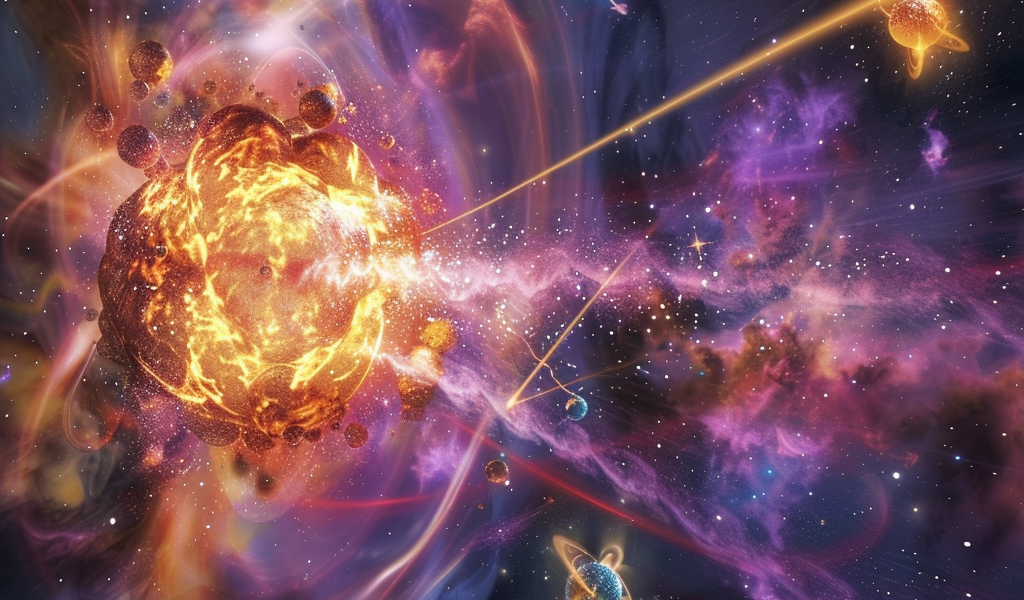The realm of particle physics is constantly evolving, and recent findings aboard the International Space Station (ISS) have sparked excitement among researchers. Eight years ago, scientists detected an unusual abundance of antimatter particles, specifically antihelium nuclei, which have posed significant challenges to our understanding of fundamental physics. The Alpha Magnetic Spectrometer (AMS-02) collaboration made this groundbreaking discovery, and new research suggests that these particles could be linked to enigmatic cosmic phenomena known as “cosmic fireballs.”
Antimatter, which consists of particles that have opposite electric charges compared to their matter counterparts, is a crucial aspect of the universe’s makeup. Theoretical physics posits that for every particle, there exists an antiparticle. However, the universe appears to be predominantly composed of matter, with antimatter being exceedingly rare. This discrepancy raises profound questions about the origins of the universe and the nature of cosmic events.
The Standard Model of particle physics, which describes the interactions of subatomic particles, suggests that half of the matter in the universe should have been antimatter. This raises a paradox: if matter and antimatter annihilate upon contact, the universe should have self-destructed shortly after the Big Bang. Yet, the observable universe is primarily made up of matter, leading scientists to investigate the mechanisms that could account for this imbalance.
While physicists have successfully created antiparticles in controlled environments, such as particle accelerators, these methods typically yield only single antiparticles like positrons and antiprotons. The AMS-02’s detection of approximately 10 antihelium nuclei, consisting of two antiprotons and either one or two antineutrons, represents a significant anomaly. If confirmed, this finding could challenge the established principles of the Standard Model.
Michael A. Fedderke, a postdoctoral researcher at the Perimeter Institute for Theoretical Physics in Canada and co-author of the study, explains that the formation of antihelium-4 requires a unique set of conditions. Specifically, it necessitates the presence of at least three or four antiprotons and antineutrons that are close enough and moving slowly enough to combine. The mechanisms that could lead to such conditions are not fully understood, which is where the concept of cosmic fireballs enters the discussion.
Cosmic fireballs are theoretical objects that could produce the conditions necessary for the creation of antihelium nuclei. These fireballs could be generated during high-energy cosmic events, such as supernova explosions or collisions between neutron stars. The energy released during these events might facilitate the formation of antimatter in quantities that could explain the AMS-02 observations.
Researchers are now delving deeper into the implications of these findings. The existence of cosmic fireballs could open new avenues of research in particle physics and cosmology. By studying the properties and behaviors of these fireballs, scientists may gain insights into the fundamental forces that govern the universe and the nature of antimatter.
The ongoing analysis of the antihelium nuclei detected by the AMS-02 is crucial for validating these theories. Future experiments and observations will help to determine whether these particles are indeed linked to cosmic fireballs or if they have other origins. The scientific community remains optimistic that these investigations will lead to a deeper understanding of the universe and its underlying principles.
As researchers continue to explore the mysteries of antimatter and cosmic phenomena, the implications of these findings may extend beyond particle physics. Understanding the balance between matter and antimatter could have profound effects on our comprehension of the universe’s evolution and its ultimate fate. The journey to unravel these cosmic secrets is just beginning, and the excitement surrounding these discoveries is palpable.
In the coming years, as technology advances and our observational capabilities improve, we may uncover even more evidence that challenges our current understanding of physics. The quest for knowledge in the field of particle physics is relentless, and each new discovery brings us one step closer to understanding the fundamental nature of reality.





